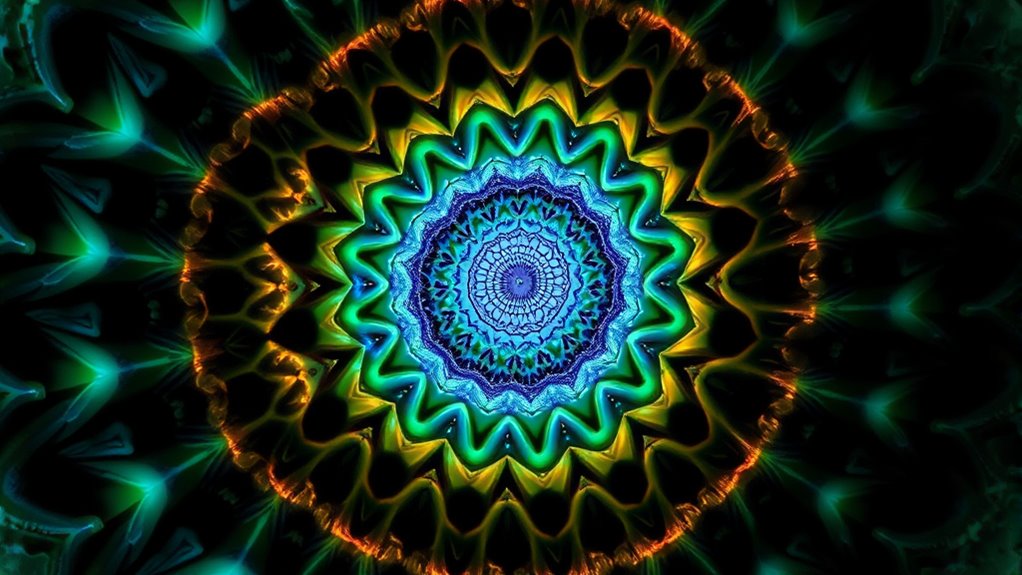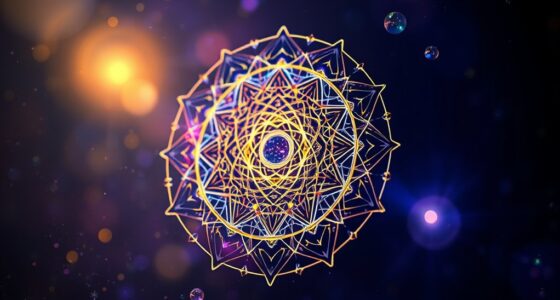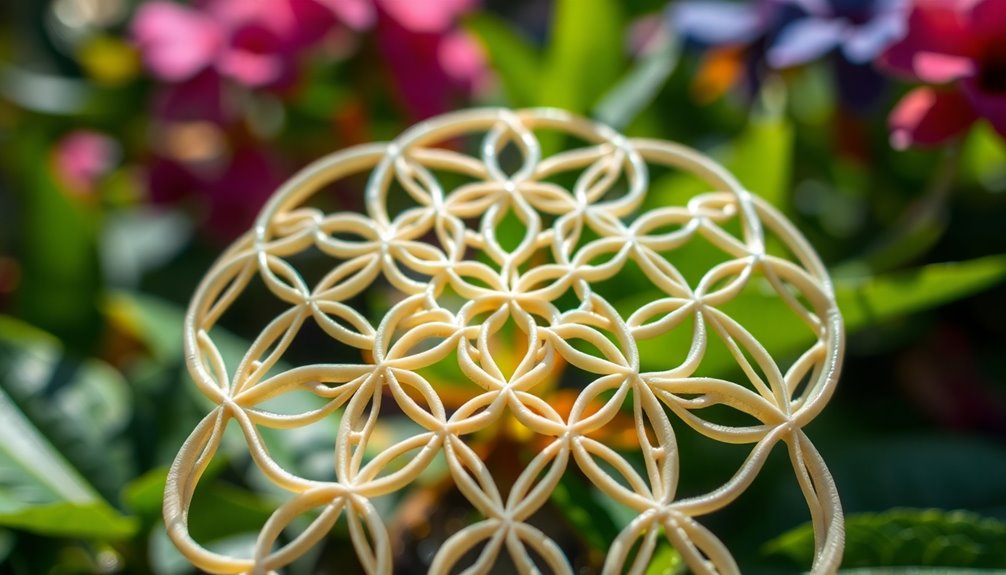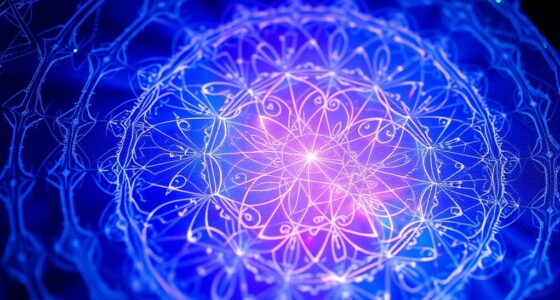Fractals act as mathematical mirrors reflecting mystical experiences because their intricate, self-similar patterns evoke awe and wonder. These repeating visuals mirror the natural world’s hidden order, showing how simple rules create complex, infinite designs. As you explore fractals like the Mandelbrot set, you’ll see how they connect to the deep harmony and mystery found in natural and spiritual domains. Continuing to explore reveals more about how math reveals the universe’s mystical beauty.
Key Takeaways
- Fractals’ infinite complexity and self-similarity evoke a sense of awe and wonder, resembling mystical experiences of unity and boundless consciousness.
- Their recursive, repeating patterns mirror spiritual visions of interconnectedness and the infinite nature of the universe.
- The mathematical beauty of fractals resonates with mystical symbolism, embodying harmony and divine order in natural forms.
- Fractals serve as visual metaphors for transcendent states, illustrating how simple rules can generate profound, mystical complexity.
- Encountering fractals can inspire moments of spiritual reflection, connecting mathematical patterns with mystical insights into reality.

Have you ever noticed complex, self-similar patterns in nature or art? These patterns, which repeat at different scales, are more than just visually mesmerizing—they reveal a hidden mathematical beauty that underpins much of the world around us. Fractals embody this idea perfectly, serving as intricate blueprints for understanding nature’s patterns. When you observe a fern leaf, the coastline, or a snowflake, you’re witnessing fractal geometry in action. These self-similar structures are not random; they follow precise mathematical rules that repeat endlessly, creating an infinite complexity within finite boundaries. This concept of self-similarity connects directly to the idea that nature’s patterns are governed by underlying mathematical principles, making fractals a powerful lens through which to explore the universe’s hidden order. Additionally, fractals demonstrate the concept of recursive growth, where the same pattern repeats at every scale, highlighting the fundamental nature of self-similarity in natural systems.
What makes fractals so fascinating is how they mirror the complexity of natural forms, yet remain rooted in simple rules. Instead of chaos, you find an elegant pattern that can be scaled infinitely, revealing an astonishing harmony between simplicity and complexity. This harmony is what mathematicians call “mathematical beauty,” a quality that resonates deeply with your sense of aesthetics and wonder. When you look at a Mandelbrot set or a Julia fractal, you’re witnessing a visual representation of this beauty—an intricate dance of shapes that seem to whisper the secrets of the cosmos. These patterns echo the recursive processes found in nature’s growth, from branching trees and river networks to cloud formations and mountain ranges. The fractal’s repeating motifs are nature’s way of organizing chaos into comprehensible order.
Frequently Asked Questions
Can Fractals Predict Mystical or Spiritual Phenomena?
You might wonder if fractals can predict mystical or spiritual phenomena. While they don’t predict events, fractal symbolism and mystical pattern recognition reveal how you interpret complex, infinite patterns in nature and consciousness. These fractal patterns often mirror spiritual experiences, helping you understand the interconnectedness of existence. Though not predictive, studying fractals deepens your awareness of mystical symbolism and enhances your perception of spiritual patterns in the world around you.
Are All Fractals Naturally Occurring or Only Mathematical?
You might wonder if all fractal patterns are naturally occurring or just mathematical. In reality, many fractal patterns appear in nature, like coastlines, mountain ranges, and snowflakes, showcasing their natural occurrences. However, mathematicians also create complex fractals through formulas. So, while some fractals are found in nature, others are purely mathematical constructs, revealing the fascinating blend of natural and human-made patterns.
How Do Fractals Relate to Consciousness and Perception?
You might wonder how fractals relate to consciousness and perception. Fractals influence your visual perception by revealing complex, self-similar patterns that your brain naturally recognizes and processes through cognitive functions. These intricate patterns can evoke a sense of wonder and deepen your awareness of the natural world’s complexity. By engaging with fractals, your mind explores new levels of perception, connecting patterns in nature with conscious experience.
Can Fractals Be Used in Therapy or Mental Health?
Imagine fractals transforming your mental health like magic! In therapy, these mesmerizing patterns can boost relaxation, reduce anxiety, and foster mindfulness. Their repetitive, infinite designs help you focus and calm your mind, revealing powerful therapeutic applications. By engaging with fractals, you can experience mental health benefits that seem almost supernatural, making them a groundbreaking tool for emotional healing and stress relief in modern mental health practices.
Do Different Cultures Interpret Fractals Differently?
You might notice that different cultures interpret fractals through their unique cultural symbolism and artistic interpretations. For example, some see fractals as spiritual symbols, while others view them as natural patterns. Your perspective can differ based on cultural background, influencing how you perceive the intricate structures. These varied interpretations highlight the richness of fractals and how they resonate differently, shaping your understanding of their significance across diverse cultural contexts.
Conclusion
You might wonder if fractals truly reflect mystical experiences. While some believe their infinite complexity mirrors spiritual insights, others see them as just mathematical patterns. The truth is, fractals challenge our understanding of nature and consciousness, blurring lines between science and spirituality. Whether or not they embody mystical truths, exploring fractals invites you to see the universe’s hidden beauty. Maybe, just maybe, they’re a mirror to the mysteries we’re still trying to comprehend.











